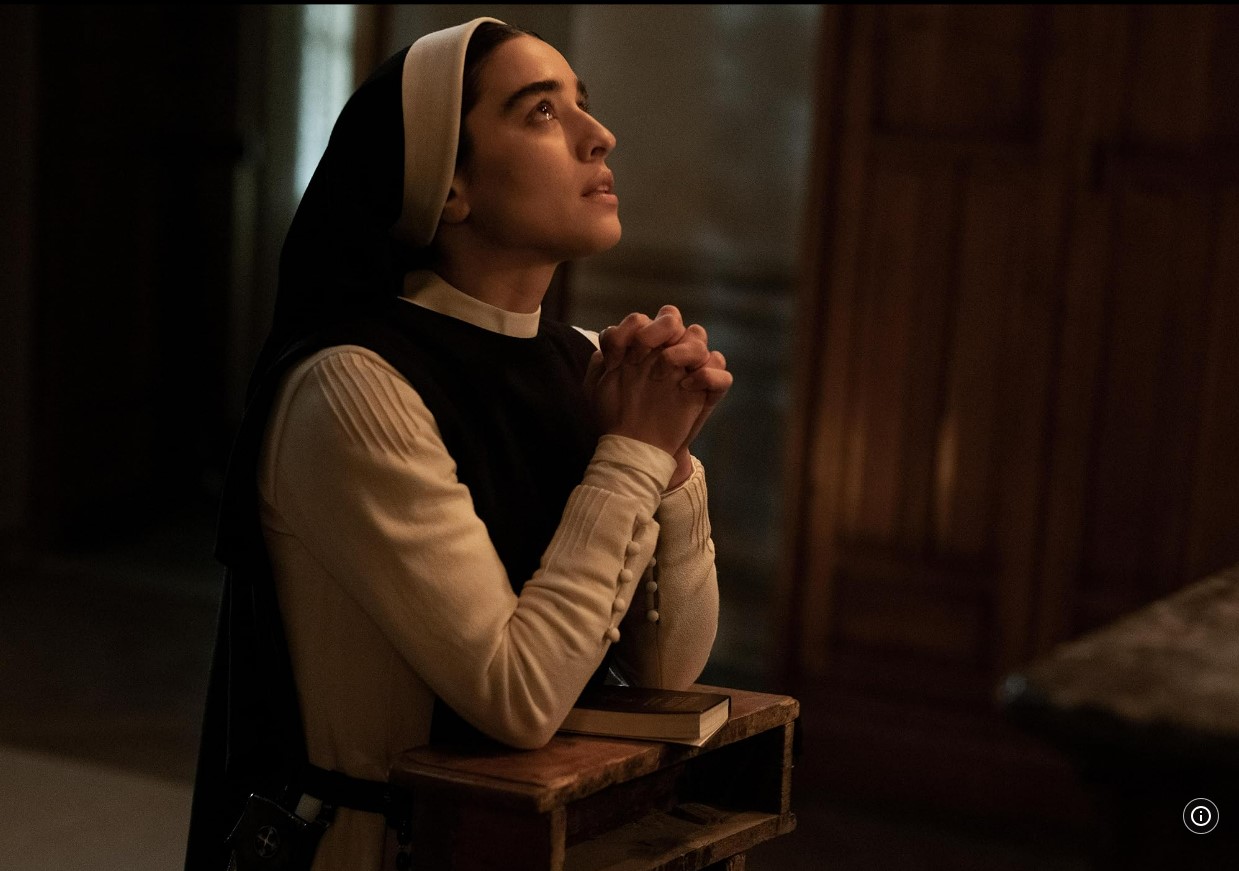Movie Info
Movie Info
- Director
- Michael Mohan
- Run Time
- 1 hour and 29 minutes
- Rating
- R
VP Content Ratings
- Violence
- 7/10
- Language
- 3/10
- Sex & Nudity
- 2/10
- Star Rating
Relevant Quotes
“Beware of false prophets, who come to you in sheep’s clothing but inwardly are ravenous wolves.
For what shall it profit a man, if he shall gain the whole world, and lose his own soul? Or what shall a man give in exchange for his soul?

Director Michael Mohel combines horror with religion in this tale of twisted religious fanaticism joined with male chauvinism. It is so bloody that potential viewers need to steel themselves as the climax looms ahead.
Postulant nun Cecilia ( Sydney Sweeney), just off the plane at Rome, is delayed by two leering customs officers who state that her becoming a nun is “a waste” of her youthful beauty. However, her Italian 101 is not enough for her to understand their lewd conversation. Her papers finally approved, she is met and driven out of Rome to a distant convent. My Lady of Sorrows has a number of nuns and postulates like Cecilia who are caring for elderly nuns in what amounts to a hospice. The gruff Mother Superior (Dora Romano) will not make you think of the convent in The Sound of Music, nor does Cecelia bear any resemblance to the irrepressible Maria.
We are given good reason to fear for Cecilia because of the grim prologue to the film in which a young nun sneaks into Mother Superior’s bedroom at nighttime, steals her ring of keys and tries to leave the grounds. Her flight is discovered—we see some nuns whose faces are covered by red cloths in pursuit. She cannot find the right key to the gate, but manages to squeeze through the opening, only to be pulled back by a pursuer. The poor girl’s ankle is broken in the struggle. The last we see of the stricken victim is her trapped within a coffin, apparently left to perish there.
| Father Sal Tedeschi (Álvaro Morte) warmly welcomes the newcomer, he being the one who had recruited her during a trip to America. We learn that he had bean a biologist before becoming a priest. The only nun friendly to Cecilia is Sister Gwen (Benedetta Porcaroli), most others treating her coldly or ignoring her. But not for long the latter, because on her second day she is summoned and given a medical by a team consisting of Doctor Gallo (Giampiero Judica), Fr. Tedeschi, and Cardinal Franco Merola (Giorgio Colangeli). Told that she is pregnant, she is sternly asked if she has been with a man, the young woman strongly denying this. The doctor affirms that physically she has not been penetrated. All agree that her condition is a miracle. She must be a second Mary bringing a new Jesus into the world!
Now treated with veneration, Cecilia is dressed by fellow nuns in a costume similar to those seen in Renaissance paintings of the Madonna, the filmmakers confusing the Virgin Birth with that of the Immaculate Conception. Pope Pius IX proclaimed in 1854: “The most Blessed Virgin Mary was, from the first moment of her conception, by a singular grace and privilege of almighty God and by virtue of the merits of Jesus Christ, Savior of the human race, preserved immune from all stain of original sin.” There are several spoilers blow, so if you plan to see this film, you might want to stop reading here. As her royal treatment increases, Cecilia becomes more disturbed with each passing day. The nuns with the red veils appear, in dreams, or is it inner reality? There are more gruesome deaths; Cecilia discovers cross-shaped scars from burning on the feet of an elderly nun; a file on Cecilia kept by Mother Superior revealing that they know about Cecilia’s childhood seven-minute death experience when she drowned in a frozen Michigan Lake; a lab where Fr. Tedeschi had conducted secret DNA experiments on numerous nuns; and Cecilia’s violent struggles with the Mother Superior, the Cardinal, and at last, as he pursues her through a catacomb beneath the convent, the priest. The girl’s climactic giving birth is harrowing, with more blood that even the I Spit on your Grave movies (or even Mel Gibson’s The Passion of the Christ). What the director does not show us in the very last scene has raised some controversy, though I am glad he left to our imagination what happens. There is little exposition in the film, so we are often confused by events and objects. Who are the red-veiled nuns? How was Cecilia impregnated, and why did not the “miracle” pregnancy attract attention beyond the convent.? Cecilia survives, but in what condition? |
This review is in the April issue of VP along with a set of questions for reflection and/or discussion. If you have found reviews on this site helpful, please consider purchasing a subscription or individual issue in The Store.

